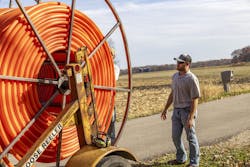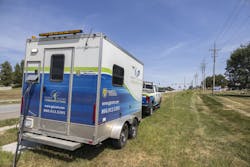How fiber has evolved, where it’s headed, and what that means for providers.
Looking back, it’s hard to believe it was the early 1980s when Great Plains Communications (GPC) buried our first fiber cables in Nebraska. Those early networks connected different locations and provided access to the internet in its early days. The 1980s saw the emergence of the Digital Age and the growing widespread use of computers and access to information. And then of course, we advanced to the days of dial-up internet connections with a maximum speed of 56 Kbps.
Early fiber builds typically had a single cable with 12 strands, and in some cases were multi-mode fiber. Today, to support the ongoing increase of bandwidth demand for real-time applications like streaming, working from home, and advanced telehealth initiatives, GPC supports a 400-gig capable, high-capacity fiber network.
Everything we deploy today at GPC is fiber-based and has been for the past several years. Other technologies had their time and place, but there’s no question that fiber-based infrastructure is superior to copper, coaxial cable, wireless and satellite delivery methods in terms of capacity, scalability, and reliability.
Fiber has evolved in several areas including:
Capacity. A fiber strand is thinner than a human hair and can transport terabytes of data per second (Tbps). This is nearly 1,000 times the capacity of copper. In addition, fiber carries information further with less signal loss. It literally travels at the speed of light.
Scalable bandwidth. Without making any changes in the fiber infrastructure itself, fiber optics can be upgraded along the way to meet today’s insatiable demand for bandwidth, which streamlines the user experience, lowers cost, and maximizes profitability for businesses. Because of the greater capacity, users can scale their service up to meet their needs and accommodate newer technologies that will inevitably be introduced over time. This ability to scale benefits all users, from residential customers to small enterprise to large healthcare, financial, and government institutions. These are great enhancements to the limitations of yesterday’s copper delivery.
Reliability. For today’s user, the network has become a necessity, like water from a faucet. It’s there when needed. Providers must have a network operations center that’s monitored 24x7, redundancy, protection against distributed denial-of-service (DDoS) attacks and other security protocols in place.
Where fiber Is Headed in 2024 and Beyond
Rising Cost of Capital Impacts Deployment
From a financial perspective, the cost of capital is higher now than in the past 20 years or so. Thus, companies must be more selective about where they build. This will be good in some ways because it will ensure that fiber builds and the investments will be in areas of the greatest opportunity. This won’t always mean that fiber will be in the areas where there is the highest need—which is where public policy makers and government-as-a-partner becomes vital.
I believe we’ll see companies being very disciplined regarding capital deployment. Our business is very capital intensive. It takes significant funding to do what we do and to make sure we’re doing it well and doing it in the right places to serve more customers, while earning the financial returns partners require.
Government Programs Spur Broadband Growth
At a time in our country when it seems like elected officials can’t agree on anything, it’s encouraging that almost everyone agrees that the policy of rural broadband deployment is a priority, with bipartisan support at both the state and federal level. This support, combined with private capital, is leading to an unprecedented level of fiber-based broadband deployment across our country.
We have a Regulatory Policy and Government Affairs team at GPC that works to support the advancement of rural broadband efforts utilizing the resources available at the state and federal level, whether it’s grant programs, universal service fund programs, or other resources. We are a participant in a program called Enhanced Alternative Connect America Model (E-ACAM), an FCC program that provides funding to deploy fiber to rural customers that are both costly and difficult to reach.
Other government broadband funding programs we have participated in during the last few years include the Nebraska Capital Projects Fund and the Nebraska Broadband Bridge Program, both facilitated by the Public Service Commission, CARES Act through the Nebraska Department of Economic Development, Nebraska and Indiana Universal Service Funds, and the Indiana Next Level Program.
Meeting Rising Customer Demand Is About More Than Fiber
Fiber Itself is Not Enough to Succeed in the Communications Business
There are a lot of companies that can put fiber in the ground and make it work. It’s not easy, but there is enough expertise that companies and startups can attempt to put in fiber. However, the ability to provide a good service experience in terms of knowing the capabilities of the network and what the users need is something else.
How you interact and help customers solve their problems is essential as a provider moves from traditional residential services to business services. Business users, as well as some of our residential customers, perform sophisticated functions using fiber. It may be a question of life or death if it’s a healthcare organization. Or significant amounts of money if it’s a financial institution.
Future-Proof Fiber
As for the technology itself, based on what we know today, fiber appears to be future proof.
There are many sophisticated companies putting a lot of effort into the optical technologies that make fiber work. But the users set the tone for those technologies. We anticipate how and to what extent our customers will want and need to use our network in terms of how we upgrade and improve the network and the products we put in place to meet their needs. Thus, as much as anything, the current and anticipated future behaviors and expectations of customers are what will continue to drive the evolution of these fiber networks.
About the Author
Todd Foje
CEO of Great Plains Communications, LLC (GPC) and Great Plains Underground Construction, LLC
Todd Foje is Chief Executive Officer of Great Plains Communications, LLC (GPC) and Great Plains Underground Construction, LLC. In this role, he provides thought leadership and guides the company by defining and implementing growth and business strategies.
Todd has more than 20 years of experience in the telecommunications industry and became CEO in 2008. He earned a Bachelor of Business Administration from Creighton University and a Master of Laws in Taxation (LLM) from Georgetown University and a Juris Doctor (JD) from George Washington University. With prior experience as both a certified public accountant and an attorney, He also has held executive roles in other industries prior to joining GPC.
For more information, visit https://gpcom.com/. Follow GPC on Twitter, LinkedIn, and Facebook.


